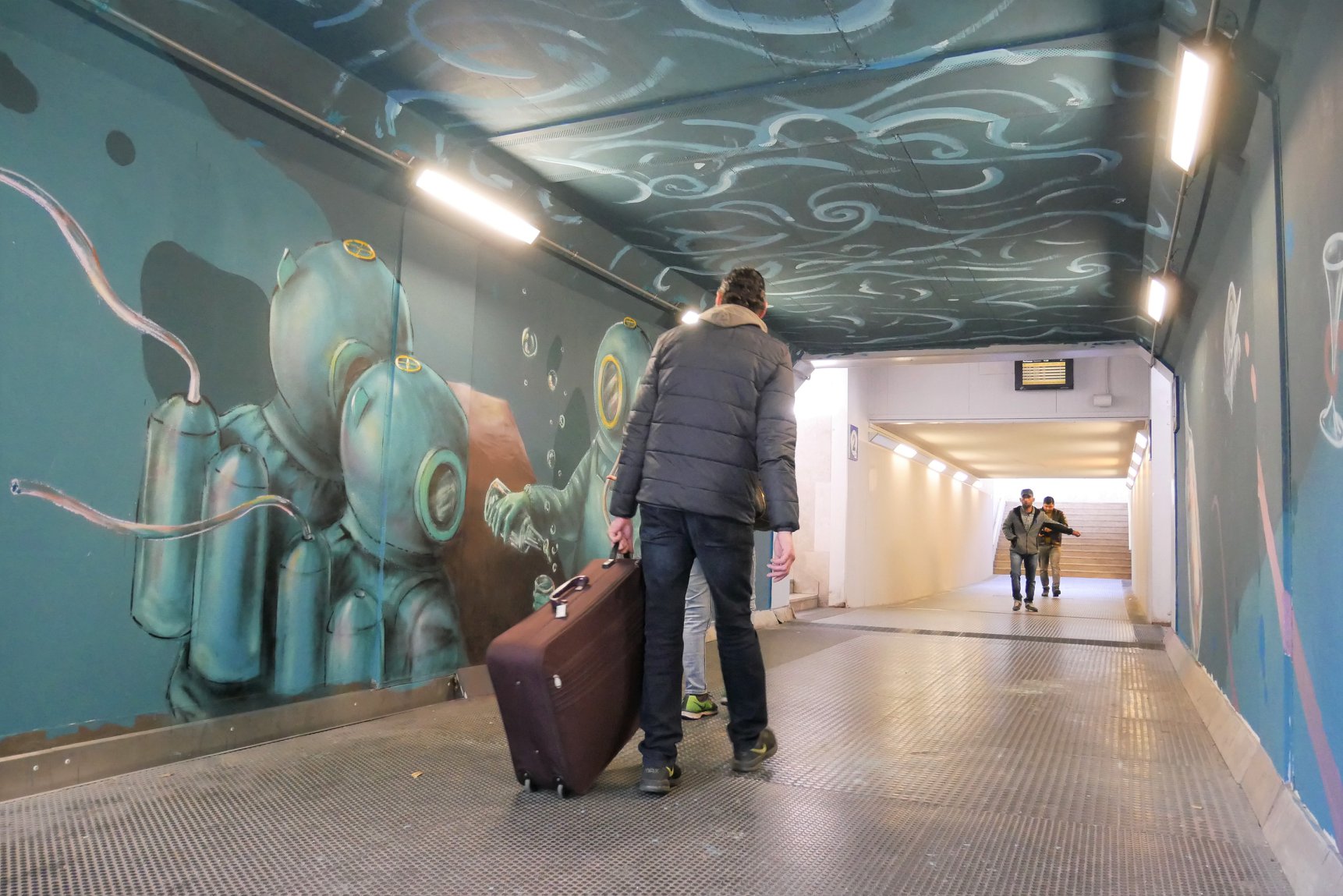Human Mind and Migration —
Art and Migration: A Journey through Artistic Experiences
The students of Messaggero Veneto Scuola are part of the impactmania’s internship program for the 2020-2021 academic year. A series of migration topics were explored in this Program that will culminate in an online exhibition and presentation, May 2021.
COVID made us all Digital Nomads, however, it didn’t stop us from cross-cultural, interdisciplinary learning.
BY CATERINA GLEREAN
For the migration project, I interviewed three people: Don Pierluigi Di Piazza, a leader at a Welcome Center near me in Italy; Tommaso Sandri who did an amazing art project in Mali and along the Balkan route; and Aida Talliente, an actress who worked with the Carovana Artistica in refugees camps.
How can art be a bridge between different cultures?
In refugees’ camps and in welcome centres art performs a task of social inclusion and communication through unconventional means. It’s a common language that we all speak around the world without the need to learn it. Witnessing an artistic manifestation is an experience with universal traits that cause different feelings in every heart.
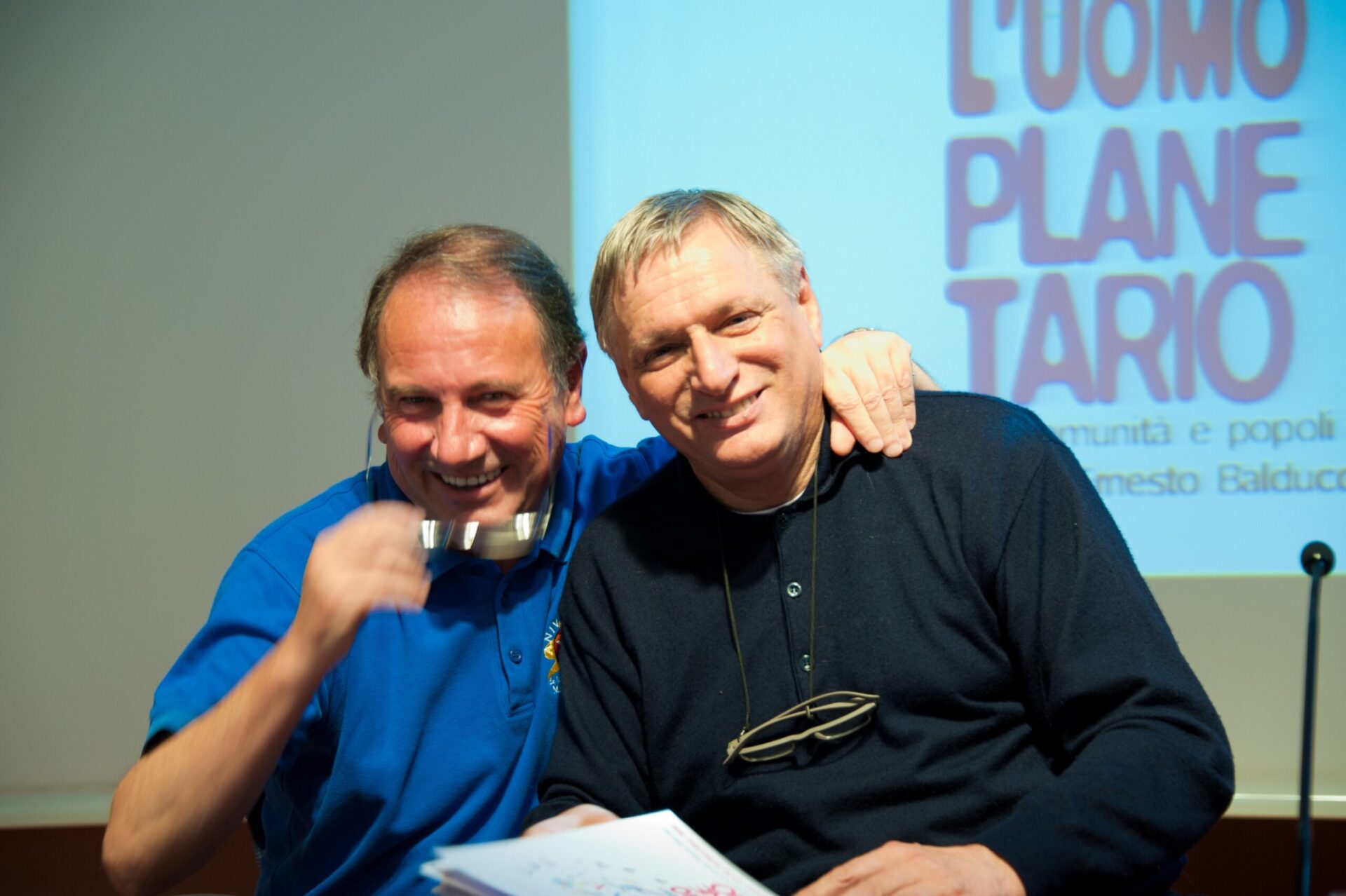
Don Pierluigi Di Piazza and Don Luigi Ciotti.
Don Pierluigi Di Piazza has founded in Zugliano, Italy the Centro di Accoglienza e di Promozione Culturale “Ernesto Balducci”. Since 1989, the Center has offered a home to migrants and refugees. Don Di Piazza offered me a direct record of how the Italian integration process works and how this is perceived by the ones with a direct experience of it.
The value of hospitality has always been extremely important since the origins of early civilization, but lately it isn’t a prominent topic. Today, many human beings have a very limited vision of the world, they focus entirely on themselves without any consideration for anyone else. Why, according to you, are we becoming less and less interested in welcoming who is in need?
Personally, I think that this isn’t a prosaic statement and I want to integrate it in a wider consideration.
Pope Francis illustrates in his last encyclical, Fratelli Tutti, (a laic encyclical because love doesn’t have borders, it is inclusive), there is a concept of the world that is technocratic, economic, based on profit and on wealth hoarding, on the impoverishment of two thirds of mankind, indifference and presumption of superiority. To this disruptive paradigm we must counterpose a new vision of the world of brotherhood, that makes us move on from indifference to participation.
Pope Francis also mentions the parable of the Good Samaritan, a laic parable because it represents lifelike situations, in which an unknown person becomes known, close, neighbour, from stranger to brother.
The topic of hospitality originates from the concept of the world people have. It is not just a face-to face relationship, this situation comes from an unsustainable paradigm. The pandemic that we are experiencing made us consider, dramatically, how we belong to only one human family and how we are all in the same situation, of life or death.
Do you think that this narrow vision of the world is a tendency we have acquired in the last decades, or does it derive from narrow visions from a further past?
This ambivalence of the human being has always been present. It’s true that from some decades this concept of the world, that is narrow and Eurocentric, is typical of the Western world that considered inferior other counties, cultures, and religions, that lead to the many forms of colonialism, of people and resources exploitation.
It’s this concept that has as a consequence the hostility, the aversion and the indifference culture. A person that we have had the pleasure to meet here (at the Centro Balducci) two times, Liliana Segre, always says that indifference is an evil worse than violence. If there are violent situations but there are also compassion and empathy towards the victims, a recovery is possible. With indiffer-ence every solidarity practice is stopped.
What value can art have in an integration process?
I think that art assumes and communicates deep and universal dimensions and becomes a human expression that facilitates in a very important way the recovery after difficult life situations.
Art expresses tragedies and sorrow but also hopes and profound joys. It has an extraordinary strength and it is also universal because it overcomes borders and walls built to keep people apart. It’s a great way of sharing.
Two years ago, an honorary degree was awarded to a Jesuit father here at Centro Balducci. The Università di Udine chose to award it to this place of welcoming, culture, and solidarity. We are talking about father Georg Sporschill, an Austrian Jesuit father that, starting from the Caritas of Wien, lived with hundreds and hundreds of homeless children that after the fall of Ceausescu regime escaped orphanages and started living in Bucharest sewers. He stayed with them, sharing their life and creating communities. Music had a meaningful role in the recovery of the children. When he moved to Transylvania with nomadic communities, the boys and the girls he met found in music an extraordinary path of expressivity and of recover from their hurt lives. When the Jesuit father came here, he was accompanied by a group of kids. At the Centro Balducci, they sang and played in an extraordinary way. A moving vividness and a strong expressiveness were clearly felt by everyone. Music embodies deep and universal dimensions. While listening to them one had in mind their troubled lives but also the possibility of liberation from them.
When we think about migration, we typically refer to young men and hardly focus on how many women and families there are. Can you tell us something more about them?
A close friend of mine, Don Luigi Ciotti spoke with the people that immersed in the Mediterranean to retrieve the bodies of the people who drowned close to Sicily. They shared their record of the traumatic experiences: finding the bodies of the mothers that had died while hugging their children. Detaching the mother and child and bringing them to the surface was an excruciating pain.
This episode is just one more that adds up to the tragedy of the Balkan Route, to the walking in the cold, in the snow, to the refugees’ camps in the island of Lesbos where, I read, young kids try to commit suicide for the tragic situation because they have no hope.
There are plenty of children that walk with moms and dads, in that infinite row coming from Guatemala, Salvador, Central America, passing through Mexico, aiming to enter the United States. And there are plenty of children that moms and dads hold in their arms, on their backs or hold hands with, during their migration journey. Also here, at the Centro Balducci, during our 33 years of experience, many children with their families or sometimes just with their moms, were welcomed, and many of them were born even when their parents had just arrived here.
I would like to recall another matter, very painful, the matter of the women that are forced by organizations to come here, in Europe, to prostitute themselves. This situation, that is unfortunately still very present today, is extremely anguishing. Women are victims of exploitation in inhumane conditions.
You have been volunteering to give interviews and speeches especially in school for many years. What do you think of sharing experiences to a public made of children and kids? Do you have faith in what the newest generations are capable of?
I have not taught for 15 or 16 years, but I’ve still been frequenting schools. The Centro Balducci has always had the aim to connect hospitality and culture through meetings, conferences, conventions, and books presentations. I am very positive about the youth because I feel that they express important sensitivity and intuition capacities. I have faith in young people, and I say this with my whole heart. I can affirm this after considering the many projects about culture and active non-violence are being realized in schools. Many young people are committed to justice and legality, always inseparable values. So, for this reason I think they are that sensitive. As we already said, they’re commit-ted to art too. I have faith in you, girls and boys, and I say this from my deepest humanity, my con-science. I have faith in you.
After Don Di Piazza’s interview, I spoke with someone that experienced the migration routes, and worked in many poor countries affected by migration events. Tommaso Sandri is a visual artist and a social operator. His work consists of combining artistic practices and social promotion through art, not just enhancing its aesthetic and visual use.
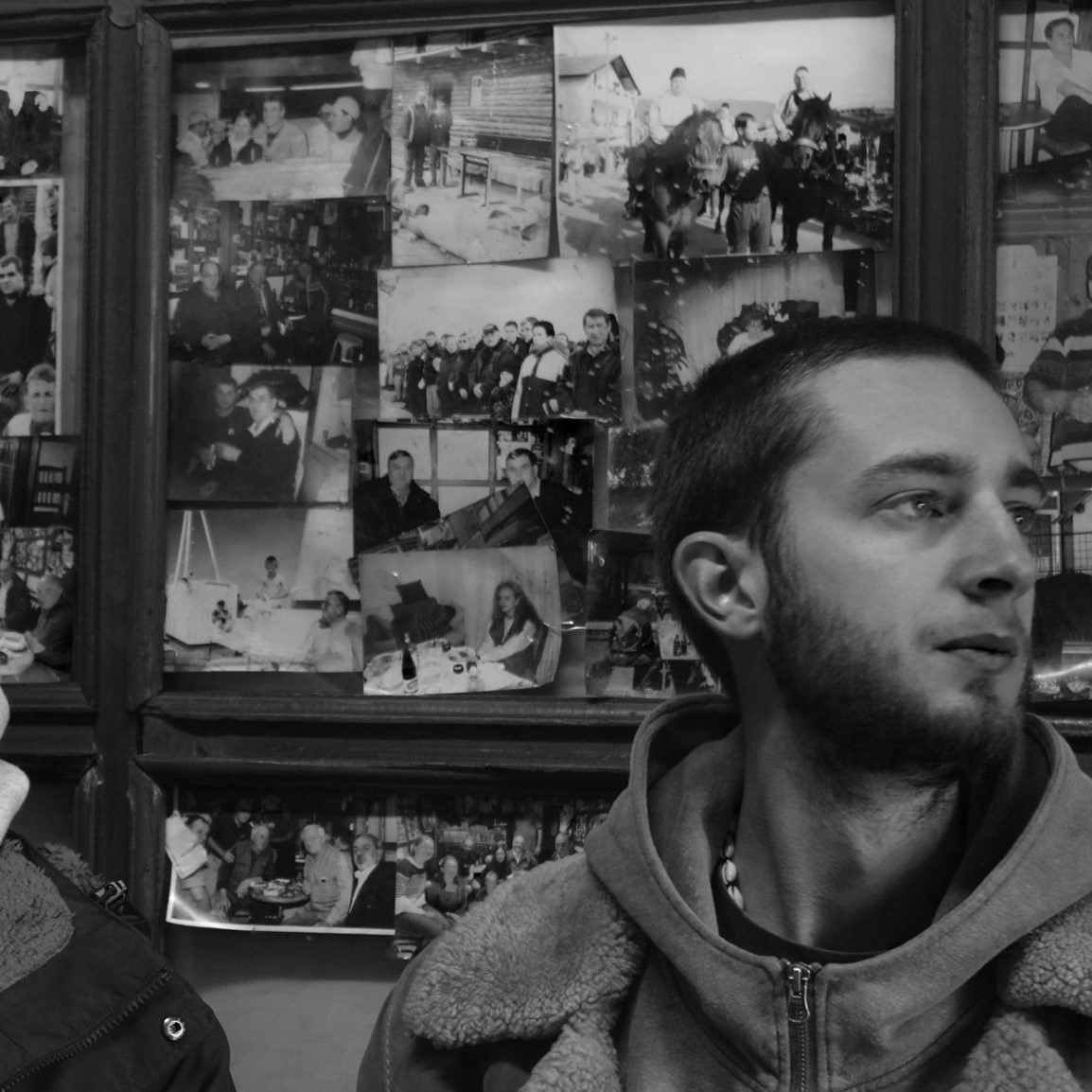
Tommaso Sandri
What do you do? Why did you choose to do this?
After finishing school, I volunteered for three months in Brazil in a community for women in poverty. There I participated in situations that used art as means of support. I understood that art could have a further usage than just aesthetics. In Brazil, I took part in projects of “participated wall paintings” in which we re-purposed some spaces of the city with the help of the population. During the journeys made during the next winters I reintroduced these projects of urban re-qualification.
In 2012, I founded with some friends, Menti Libere, a union of artists that uses art as means of social promotion, and encourages many initiatives in Friuli Venezia Giulia, Italy that range from the organization of environmental cleaning events to long projects of participated urban re-qualify such as enhancing the train station of Latisana.
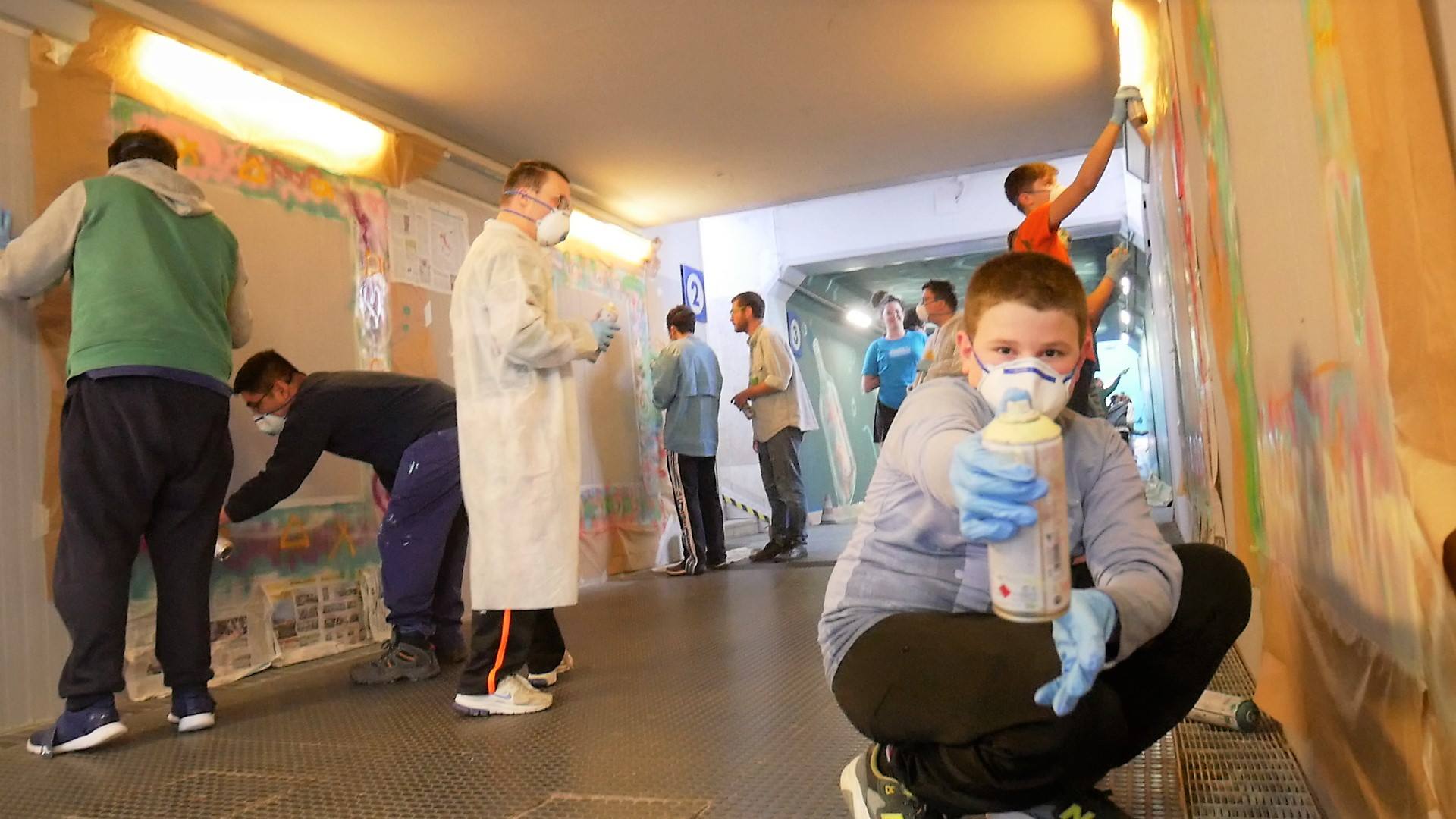
We organized a project with refugee children from Afghanistan and Pakistan that were living in Lignano, Italy. That happened in a period when hardly anybody talked about the Balkan Route and no one was aware of that reality so close to us. This project made us curious of what happens at the borders of Europe.
At the end of 2015, I traveled with two of my friends for three months — we went 4,000 kms from Lignano to the border between Turkey and Syria. Where it was possible, we volunteered to help. Our first idea was to bring recreational opportunities to refugees’ camps. We brought with us a 30-meter sheet of paper, markers and musical instruments, and we shared them with everyone. Every time, we saw dozens and dozens of children, in front of an immense paper sheet, immediately starting to draw. This caused strong and instant reactions, also an equal situation because we weren’t using a language. Drawing was our way of communication.
The children’s older siblings would also join in and then the parents. All of them narrated them-selves through the drawings.
After that, I kept bringing new paper sheets when I found myself in places affected by migration. I’ve been in Calais, in the Calais Jungle, and there in just one afternoon all of the 30 meters were filled with drawings.
I traveled a lot: one journey was from Lampedusa to Rome, visiting all the welcome centers along the route. I’ve been to Bosnia twice, with the Carovana Artistica with Micol Sperandio and Aida Talliente, once in detention camps (that burned recently) and once with the Bosnian war survivors, and people that have lived in refugees’ camps for close to 30 years.
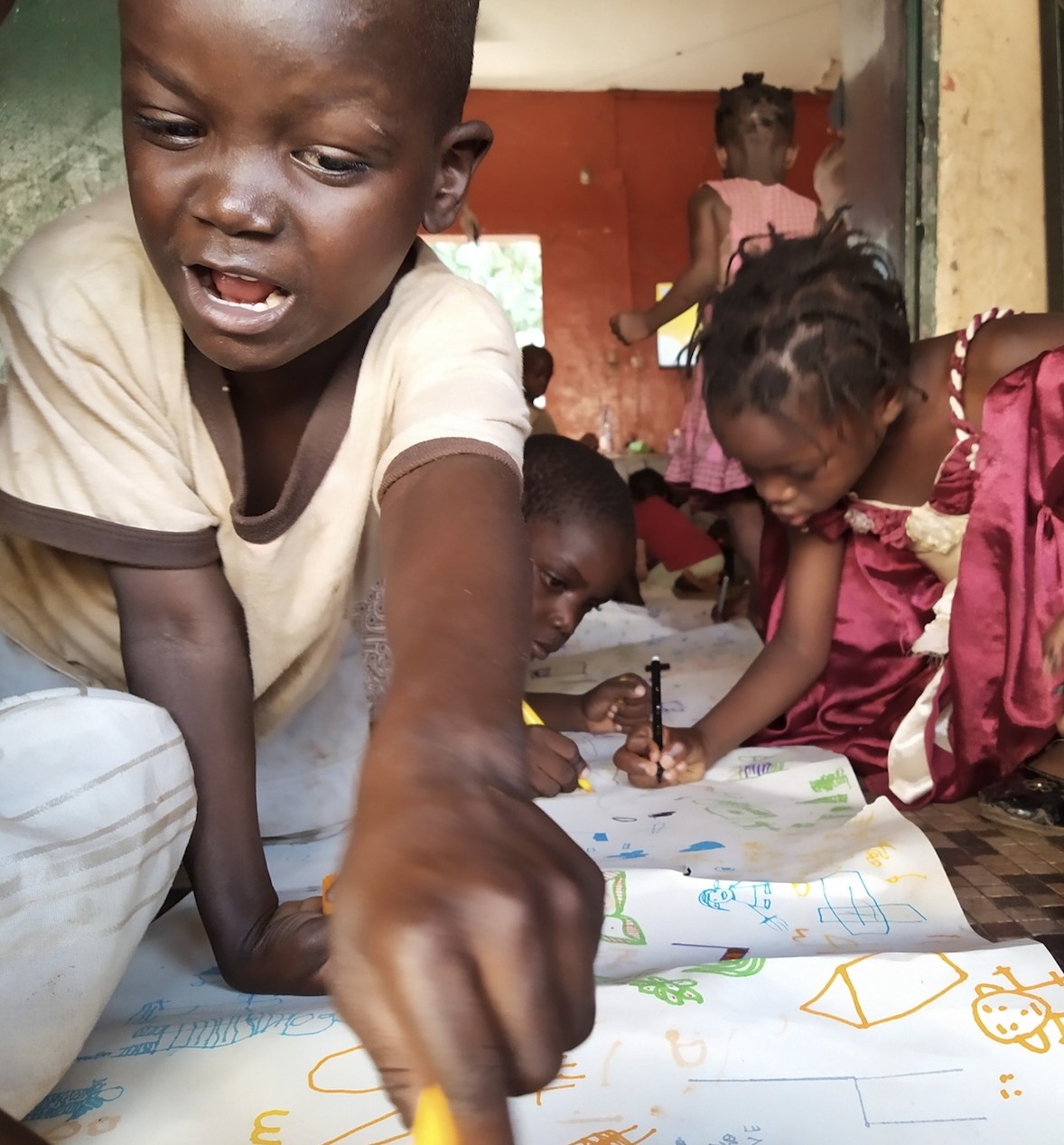
The last project with the paper sheet was last year in Mali, a place wounded by the 2012 civil war. We contributed to the construction of a playground with recycled iron. We also brought the paper sheet that was drawn on by children of different ethnicities, conflicted in the country, but in peace on that piece of paper.
In villages between Senegal and Gambia, I visited families of friends I worked with here in Italy. These families lived in isolated rural villages, where almost the 70% of the youth leaves, because the only means of living is agriculture. However, water is insufficient and cultivation is only possible for two months a year. Usually, people migrate to big cities in the same countries, or other African countries, and just a small part outside the continent, here in Europe.
What makes art social promoting?
Art, every form of it, is a universal language, the language that’s the closest to the divinity, called Allah, God or whichever other name. It connects everyone by nature, it doesn’t discriminate. It’s a way of promoting values. When people are engaged by its language, group dynamics that were difficult to achieve are reached.
For the projects of the association Menti Libere that we promote here in Friuli, we work with very heterogeneous groups of people. In Latisana, we encourage middle-school kids to collaborate with kids affected by physical disabilities. Before trying to reach a finished artistic product by painting, the artistic journey is very long: many creative and artistic activities are conducted with the goal of reinforcing the group dynamics, of increasing the kids’ self-esteem, and of making them the protagonists. With these activities, they are involved in first person, collaborating with each other.
What does “sharing experiences through art” mean?
Art is self-representative and limit-overcoming, because through it we can better see ourselves. Art is born from a visceral need of making things come out from us, good and bad things. Everyone has this need and everyone has their own language. It’s a need self-examination and of overcoming personal limits: just after this phase it can become something to help other people to do the same.
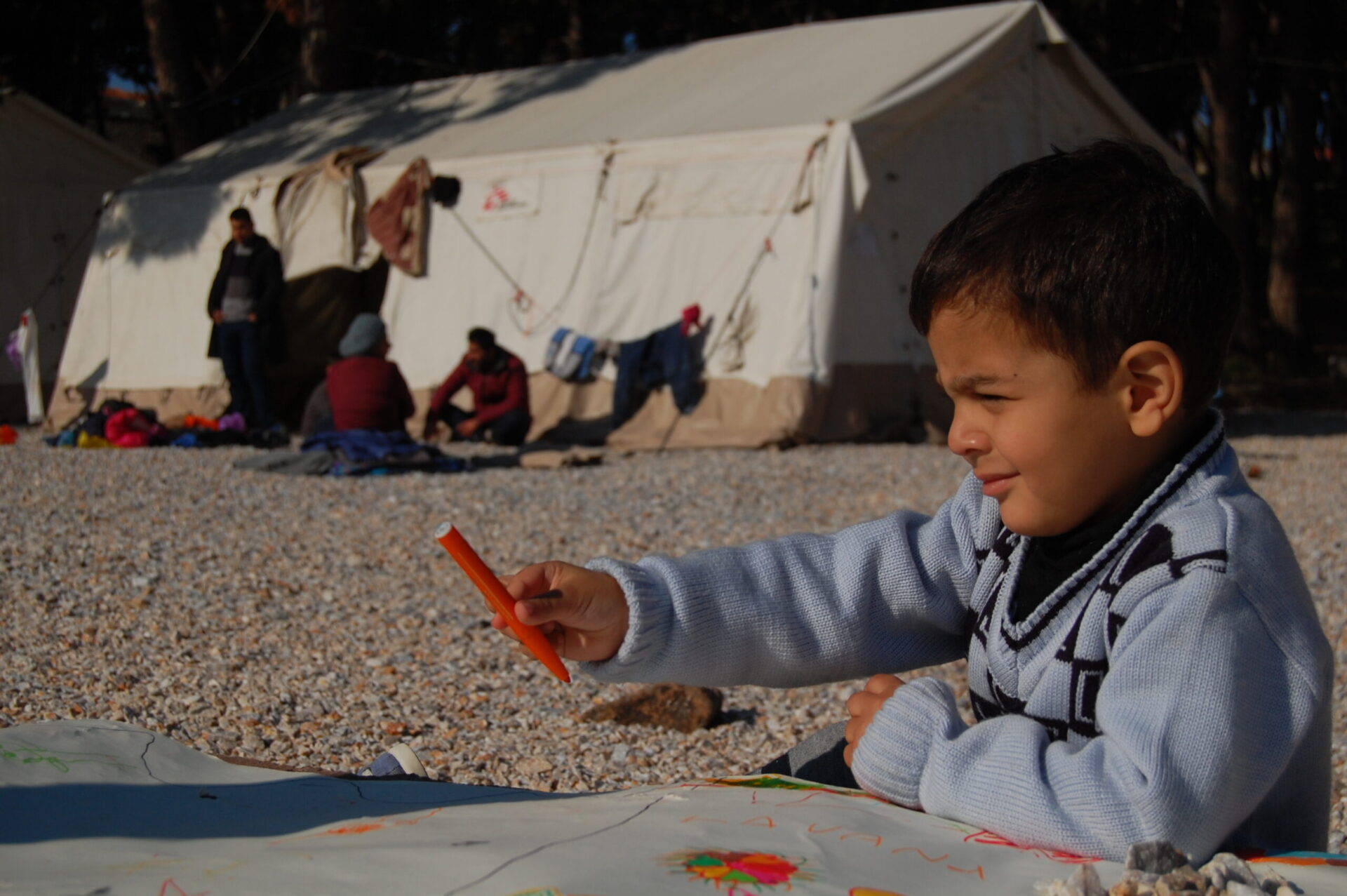
Can you share some important experiences that touched you?
I remember the moment in which I realized how my 30-meter sheet of paper could be amazing.
Preševo, on the border between Serbia and Macedonia, is a little and very impoverished town. Up to some years ago it was one of the hot spots of the Balkan route: in its train station there are many and many migrants. When we arrived, there were thousands of people waiting. There was a militarized refugee camp, in which volunteers couldn’t do much. We could interact with people only in the station and we could only meet people that had just arrived or people that were waiting for a train to go to Belgrade or to Šid, on the Croatian border.
We couldn’t volunteer in the camp and we were in an impasse. There were differences between us and the migrants: we were white and we didn’t know their language.
At some point we unrolled the paper sheet and something very important happened: immediately the children that were playing on the railtracks came from everywhere and started drawing. Just after them entire families came and those differences that immediately before were so big didn’t exist anymore.
Another touching episode happened two years ago in Bosnia, when I was with the Carovana Artistica. We were in a detention center, extremely militarized, in which soldiers entered to threaten people, in which everyone lived together, families with children, and even kids by themselves, in a crumbling warehouse filled with tents. I was finishing a mural with other people when Aida and Nicole unrolled the paper sheet in the warehouse. Immediately, fifty or sixty people arrived: they were al-most all adults. Everyone told their story, freely, without solicitations of any kind. We are used to the journalist that comes with a microphone and a camera pointed at the people asking a hundred questions. Obviously, then people close themselves off. But by drawing and nothing being asked, everyone is free to let of steam.
“Art, being music, theatre, drawing or any of its forms, is a universal language. A language that puts us more in contact with the divinity, Allah, God, or whatever. Art connects everyone without discriminations”.
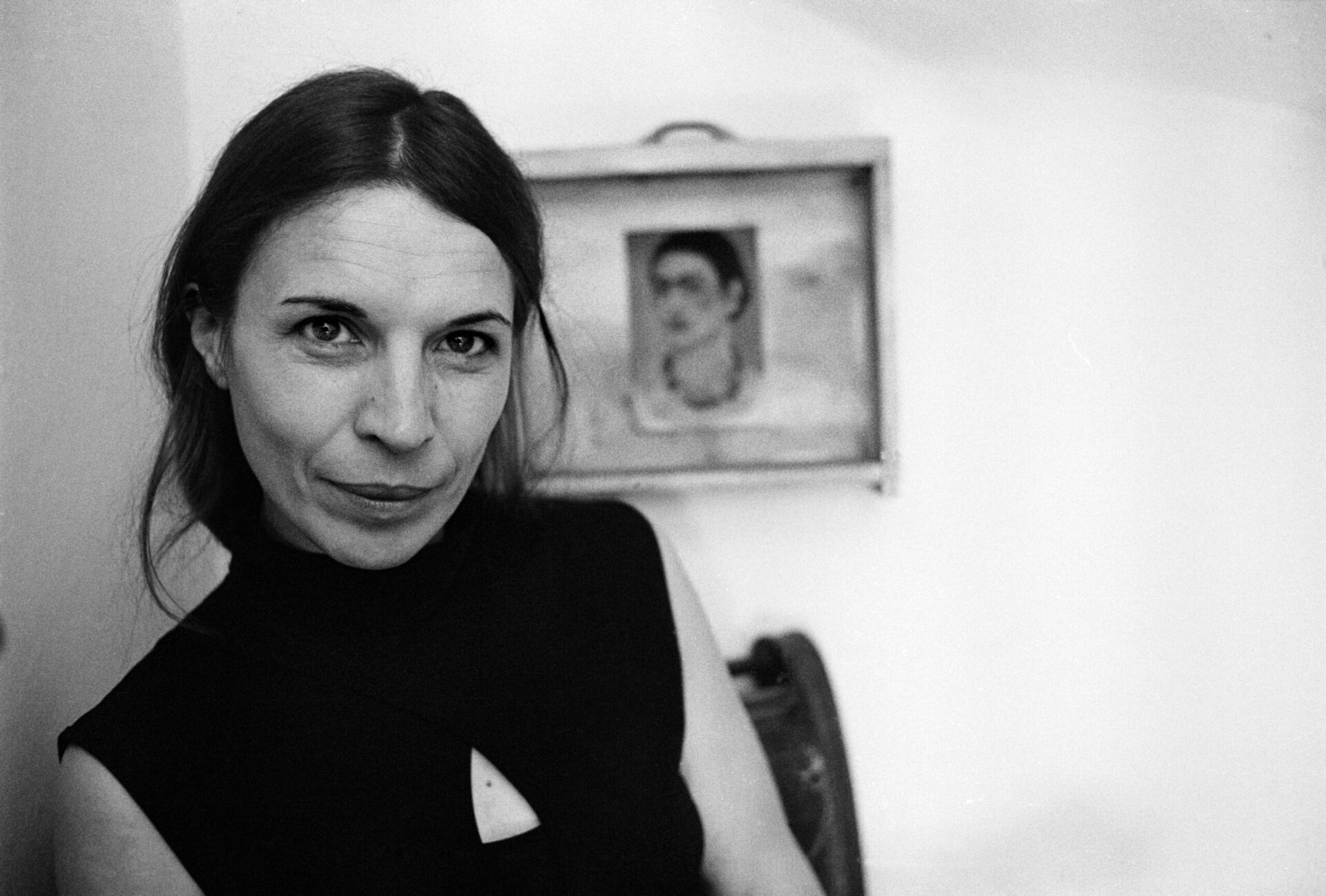
Aida Talliente
I also met Aida Talliente, an actress that focuses her work on teatro d’indagine, which consists of sharing real experiences through plays. For her, theatre has an important social function; it transmits ethic and political values.
For this reason, Aida is committed to listening, collecting, and telling the stories that people tell her during interviews. During the years she chose to work, in addition to theatres, also in particular situations, many of them very problematic, like refugee camps in Greece, Giordania, and Bosnia, collaborating with the Carovana Artistica.
The goal of this association is to bring joy and beauty through art in places where people are afflicted by troubled backgrounds.
What does the word theatre mean? What is the meaning of acting?
In some places theatre is a cheerful entertainment, it’s a meeting point for the community, somewhere else doing theatre can kill you, while in other places it can save you. In these particular situations, theatre reclaims its important social value. It becomes ethic, political, necessary, spiritual, human, moving, intimate. It becomes sacred too, because the substance that forms it is alive. And this life allows who is doing it and who is receiving it to feel a sensation that nourishes our mind, that changes us, and that touches our sensitivity. Theatre is a rite. An actor is someone that gets ready and trains to officiate that rite. He becomes a vehicle for words, people, and history.
I started to collect stories, becoming their author to stage them. This meant knocking on doors of people I didn’t know, travelling, searching, asking, speaking, and listening. Most of the times stories show up spontaneously, but sometimes they have to be searched. They are the lives of people, the faces that I can’t forget because of their eyes and wrinkles. Telling their stories means becoming their memory. A memory necessary to not commit the same errors and horrors that fill the past and unfortunately also our present. It’s a form of resistance.
Much care, attention, a particular sensitivity and much work are needed. The body needs to be prepared and trained because it becomes an instrument that is needed to feel again important sensations of our lives: love, friendships, relatives, sorrow. All these elements, that belong in a deep and intimate dimension of us, are very important engines for an actor’s work.
In the years, thanks to theatre, I had the occasion to work is very particular situations, sometimes difficult or extreme. With an acting company from Rome, I worked with indigenous people in Brazil, with nomad communities in Malawi, and with the ex-soldier-girls in the Ivory Coast. Lately, I’ve been in refugee camps in Greece, in Jordan, in Bosnia, with other people all part of an association called Carovana Artistica.

Could you explain how the Carovana Artistica works and what are its goals?
The founding reason was to bring beauty and hope in places that didn’t have them anymore, with the help of people that chose to make art, culture, and education their job. Acknowledging the tools we have as teachers, actors, musicians and the love we feel for our job, we wanted to see what were the life (or non-life) conditions in refugees’ camps. We went to Greece, to Jordan — entering the second largest refugee camp in the world, Zaatari, “inhabited” by 80,000 people — in Serbia and in Bosnia. We didn’t certainly have big financing and big structures because our work is volunteered, but we have an extraordinary community that always supported us and our work. Including a few libraries in Udine, Italy that take care of book donations, the Centro di Accoglienza Balducci in Zugliano, Oikos Onlus, Ospiti in Arrivo, and many other citizens. We bring illustrated books, written in different languages, very important in places in which there are none and kids can’t read them.
When something beautiful happens in places that are similar to hell, that beauty is welcomed sincerely, and becomes contagious. Big international organizations work in most of the camps, and, despite their financial means, sometimes they employ staff that do not have the specific skills to work in those extreme conditions. Most of the time children that can’t read and write are neglected.
Why did you choose to work abroad?
For many years people have told me, “There’s no need to go that far, there’s much work to do here too”. I always answer that when there’s something to do here, we are the first to be present to help, but I also assure that abroad the conditions are very alarming. In Bosnia, the refugees’ camps are old abandoned factories, in which containers or tents are built and lavatories are insufficient. Over-crowding is everywhere, men, women, and children all live together. Many ethnicities are forced to live together in defined places. During the day there’s nothing more to do than waiting in line for the three daily meals.

Why do you think bringing art to children that live in those situations is necessary?
Often people tell me “Books, toys, smiles, music and pretty things aren’t necessary to change the situation”. I always answer “Yes, they are necessary”. Every human being deserves to receive care, attention, and beauty, even in places where beauty seems to be non-existent. We have to realize how really important it is to educate children to read, write, play, smile, and cultivate feelings of affection, and not of hate. If we don’t understand that it’s us adults that must bring peace, justice, harmony, and love around them, things can’t change.
A child that can’t read and write, and lives in contexts of tension and abuses, will be an adult that bring him or herself to these problems. They won’t be able to tell apart good from bad things, won’t know his rights, or his duties. The future is being built now. I believe that the preparation to peace through education is the most efficient endeavour against dehumanisation and war. We have to start with children. Only this is how we can hope for a future of peace.
Art is really an international language: a language of hope and safety. It opens doors that otherwise would be permanently closed, it destroys walls built by prejudice, different cultures and apparent differences. Indeed, those last disappear. Integration in a new country is facilitated. Hope is reborn. Music, theatre, and drawing are just some of the thousands of artistic expressions that make all this possible, when they are in the hands of people like don Pierluigi Di Piazza, Tommaso Sandri, and Aida Talliente, who everyday make themselves available to help others.
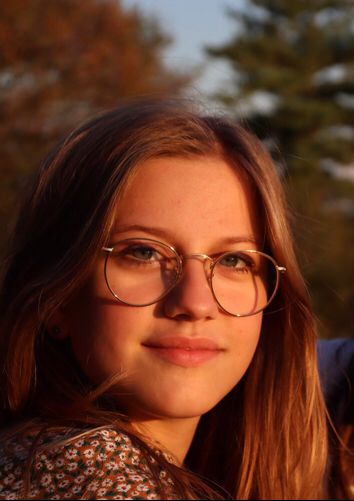 Caterina Glerean (17) was born in Udine, Italy. Caterina attends the classical high school Liceo Jacopo Stellini, focused on humanistic studies. She was part of the youth editorial staff of the local newspaper Messaggero Veneto Scuola and the impactmania student internship program in 2020-2021. Caterina enjoys art, literature, and music. For the last few years, she has been an active member of the local group of Fridays for Future and of the Rete degli Studenti Medi, an Italian high-school students’ union.
Caterina Glerean (17) was born in Udine, Italy. Caterina attends the classical high school Liceo Jacopo Stellini, focused on humanistic studies. She was part of the youth editorial staff of the local newspaper Messaggero Veneto Scuola and the impactmania student internship program in 2020-2021. Caterina enjoys art, literature, and music. For the last few years, she has been an active member of the local group of Fridays for Future and of the Rete degli Studenti Medi, an Italian high-school students’ union.
